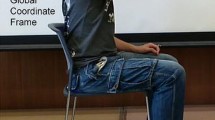Abstract
The quantitative assessment of human joint torque capability has manyimportant applications. By means of a multibody approach, the authorsdescribed a formulation for 3D inverse dynamic analysis of a human armduring voluntary free movement. In particular, it is presented as a testcase where the kinematics of the arm is obtained by means of a video-based human motion analysis system.
Similar content being viewed by others
References
Huston, R.L., Multibody Dynamics, Butterworth-Heinemann, Portland, 1990, 366–370.
Terze, Z., Lefeber, D. and Muftić, D.,‘Null space integration method for constrained multibody system with no constraint violation’ in Advances in Computational Multibody Dynamics, J.A.C. Ambró sio and W. Schielen (eds), IDMEC/IST Lisbon, Portugal, September 20-23, 1999, 789–799.
Silva, M.P.T., Ambró sio, J.A.C. and Pereira, M.S.,‘Biomechanical model with joint resistance for impact simulation’ Multibody System Dynamics 1, 1997, 65–84.
Wood, G.A. and Marshall, R.N.,‘The accuracy of the DLT exrapolation in three-dimensional film-analysis’ Journal of Biomechanics 19, 1986, 781–785.
Haug, E.J., Computer-Aided Kinematics and Dynamics of Mechanical Systems, Vol. I, Allyn and Bacon, Boston, MA, 1989.
Pennestrì , E., Elements of Technical and Computational Dynamics, Editrice Aracne, Rome, 2000 [in Italian].
Brutti, C., Pennestrì , E. and Urbinati, F.,‘Kinematic analysis of spatial mechanisms by means of Maple’ MapleTech 5, 1999, 49–57.
Latash, M.L., Arvin, A.S. and Zatsiorsky, V.M.,‘The basis of a simple synergy: Reconstruction of joint equilibrium trajectories during unrestrained arm movements’ Human Movement Sciences 18, 1999, 3–30.
Schmidt, R., Disselhorst-Klug, C., Silny, J. and Rau, G.,‘A measurement procedure for the quantitative analysis of the free upper-extremity movements’ in Proceedings Fifth International Symposium on the 3-D Analysis of Human Movement, Chattanooga, TN, July 2-5, M. Whittle (ed.), 1998, 47–54.
Renzi, A.,‘Telemetry surveying and 3D dynamic modeling of the human upper limb’ Tesi di Laura, University of Rome‘Tor Vergata’ A.A.1998-99 [in Italian].
Woltring, H.J., Huiskes, R., de Lange, A. and Veldpaus, F.E.,‘Finite control and helical axis estimation from noisy landmark measurements in the study of human joint kinematics’ Journal of Biomechanics 18, 1985, 379–389.
Sommer, H.J.,‘Determination of first and second order instant screw parameters from landmark trajectories’ ASME Journal of Mechanical Design 114, 1992, 274–282.
Clauser, C.E., Young, J.W. and McConville, J.T.,‘Weight, volume and center of mass segments of the human body’ Wright Patterson Air Force Base, AMRL-TR-69-70, 1969.
Chandler, R.F., Clauser, C.E. and McConville, J.T.,‘Investigation of properties of the human body’ Wright Patterson Air Force Base, AMRL-TR-74137, 1975.
Raikova, R.,‘A general approach for modelling and mathematical investigation of the human upper limb’ Journal of Biomechanics 25, 1992, 857–867.
Angeles, J.,‘Automatic computation of the screw parameters of rigid body motions. Part I: Finitely-separated positions’ ASME Journal of Dynamic Systems, Measurement and Control 108, 1986, 32–38.
Angeles, J.,‘Automatic computation of the screw parameters of rigid body motions. Part II: Infinitesimally separated positions’ ASME Journal of Dynamic Systems, Measurement and Control 108, 1986, 39–43.
Angeles, J.,‘Computation of rigid-body angular acceleration from point-acceleration measurements, ASME Journal of Dynamic Systems, Measurement and Control 109, 1987, 124–127.
Gupta, K.C. and Chutakanonta, P.,‘Accurate determination of object position from imprecise data’ ASME Journal of Mechanical Design 120, 1998, 559–564.
Gupta, K.C.,‘Measures of positional error for a rigid body’ ASME Journal of Mechanical Design 119, 1997, 346–348.
Laub, A.J. and Shifflett, G.R.,‘Linear algebra approach to the analysis of rigid body displacement from initial and final position data’ ASME Journal of Applied Mechanics 49, 1982, 213–216.
Shifflett, G.R. and Laub, A.J.,‘The analysis of rigid body motion from measured data’ ASME Journal of Dynamic Systems, Measurement and Control 117, 1995, 578–584.
Spoor, C.W. and Veldpaus, F.E.,‘Rigid body motion calculated from spatial coordinates of markers’ Journal of Biomechanics 134, 1980, 391–393.
Veldpaus, F.E., Woltring, H.J. and Dortmans, L.J.M.G.,‘Least squares algorithm for the equiform transformation from spatial marker coordinates’ Journal of Biomechanics 21(1), 1988, 45–54.
Author information
Authors and Affiliations
Rights and permissions
About this article
Cite this article
Pennestrì, E., Renzi, A. & Santonocito, P. Dynamic Modeling of the Human Arm with Video-Based Experimental Analysis. Multibody System Dynamics 7, 389–406 (2002). https://doi.org/10.1023/A:1015573611400
Issue Date:
DOI: https://doi.org/10.1023/A:1015573611400




